|
|
|
Sort Order |
|
|
|
Items / Page
|
|
|
|
|
|
|
| Srl | Item |
| 1 |
ID:
181229


|
|
|
|
|
| Summary/Abstract |
This article investigates the context and development of the Israel Defence Industries (IDI) during the period 1930–2018. During this timeframe, the IDI was forced to transform several times with the Israel Ministry of Defence acting as the main facilitator. Well established links among government institutions, academia, investors and the IDI contribute to armament quality and innovations which supports market expansion. Nevertheless, US support remains an important enabler in facilitating the IDI developments. Nowadays, the IDI is an important player in Israeli economics that contributes to the exports and facilitates developments in other sectors.
|
|
|
|
|
|
|
|
|
|
|
|
|
|
|
|
| 2 |
ID:
109920


|
|
|
| 3 |
ID:
052931


|
|
|
|
|
| Publication |
Apr-Jun 2004.
|
| Summary/Abstract |
An analysis of the federal financial records reveals shocking evidence that a very large poportion of the nation's wealth is eing illegally diverted since several decades ino secret, unaccountable channels and programmes with unspecified purposes, including covert operations and subversions abroad and clandestine military R&D at home.Public institutions have been infiltrated and taken over by shadowy groups in the service of powerful private and vested interests, often at the expense of the common good.
|
|
|
|
|
|
|
|
|
|
|
|
|
|
|
|
| 4 |
ID:
079647


|
|
|
|
|
| Publication |
2007.
|
| Summary/Abstract |
An ever-growing share of defence R&D expenditures is being dedicated to the development and fielding of integrative technologies that enable separate individual systems to work in a coordinated and synergistic fashion as a single system. This study explores the optimal defence budget allocation to the development and acquisition of weapon systems and to the development of integrative technologies. We develop a suitable optimization framework, and then use it to derive the optimal budget allocation and analyse its properties. Finally, we use US defence budget data to calibrate the parameters of the model and provide a quantitative measure for the apparent US military supremacy.
|
|
|
|
|
|
|
|
|
|
|
|
|
|
|
|
| 5 |
ID:
113700
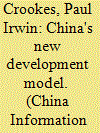

|
|
|
|
|
| Publication |
2012.
|
| Summary/Abstract |
This article examines China's innovation strategy as a key part of its economic development policy to achieve the next stage of the country's domestic market modernization. The news that China now possesses the world's fastest supercomputer appears to confirm the country's inexorable journey from the world's manufacturer and assembly hub to leading global innovator. However, this article presents an examination of broader-based innovation metrics which casts a different light on China's position, showing that much work still remains to be done in order to lift domestic innovative activity to world-class levels. The country is certainly a challenger, but does not yet appear to have become a leader. The article draws on the latest research data of China's innovative capabilities and links these to empirical assessments of the country's information and communications technology sector to illustrate current strengths and weaknesses. In conclusion, it is argued that key inhibitors remain in the context of creating commercially sustainable competitive advantage in science and technology, and that the strengthening of moves towards nationalist innovation strategies may be counterproductive as China embarks on a critical phase of its engagement with the global research and development community.
|
|
|
|
|
|
|
|
|
|
|
|
|
|
|
|
| 6 |
ID:
090467


|
|
|
|
|
| Publication |
2009.
|
| Summary/Abstract |
Defence R&D is known to be a mission oriented activity comprising both basic and applied research, which involves development and fabrication, as well as testing of new weapons and weapon systems. The need today at the world level is project -based intensive R&D, so as to come up with high quality items even if it means a slight compromise on quantity. India is also in the churning process of deciding what the priorities should be.
|
|
|
|
|
|
|
|
|
|
|
|
|
|
|
|
| 7 |
ID:
139482


|
|
|
|
|
| Summary/Abstract |
The information technology (IT) sector has contributed significantly to the economic growth in India and is one of the fastest-growing export-oriented sectors in India. The objective of this article is to explore the determinants of exports of IT companies of India from 2000 to 2012 using company-level data. Applying ordinary panel data regression, the article finds that world demand and real effective exchange rate have expected signs on company exports. Surprisingly, foreign capital, which played a crucial role in IT sector development in India, has a negative coefficient, highlighting substitution relation between export and domestic demands. The dynamic panel data regression exhibits persistence of exports which acts as a moderating factor on demand fluctuations and its high impact. Further, the dynamic panel estimations clearly show the predominant influence of past exports on gross domestic product (GDP) growth in India, which makes world demand, standardized as relative to India’s GDP, inconsequential for its future exports.
|
|
|
|
|
|
|
|
|
|
|
|
|
|
|
|
| 8 |
ID:
165348


|
|
|
|
|
| Summary/Abstract |
We explore the efficacy of counterespionage measures in the realm of Economic Espionage. Although it is possible that increasing counterespionage measures has the desired effect of increasing domestic research and development (R&D) and reducing espionage by foreign entities, it is also possible that these increased measures actually do just the opposite: domestic R&D suffers and foreign stealing increases. We identify the appropriate settings for increased counterespionage measures and provide some policy advice.
|
|
|
|
|
|
|
|
|
|
|
|
|
|
|
|
| 9 |
ID:
182630
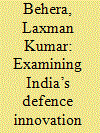

|
|
|
|
|
| Summary/Abstract |
India has expended a great deal of energy and resources to set up a vast defence economy to innovate state-of-the-art weapon systems. However, the performance of the defence economy has been largely suboptimal. An examination of the causes of poor performance exhibits a number of shortcomings related to India’s both ‘hard’ and ‘soft’ innovation capacities. Lack of strong support from higher political leadership, meager research and development (R&D) and procurement budgets, inefficiency of the main R&D and manufacturing players, poor management of human resources and a weak acquisition system, among others, leave India’s defence innovation in a poor state.
|
|
|
|
|
|
|
|
|
|
|
|
|
|
|
|
| 10 |
ID:
190153
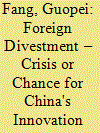

|
|
|
|
|
| Summary/Abstract |
The recent move towards decoupling from China, prompted by the 2018 trade conflict, has implications for the innovativeness of Chinese firms. Using patent data from the Chinese State Intellectual Property Office, together with comprehensive firm-level data, and applying an inverse propensity score reweighting methodology to deal with selection bias, we estimated changes in the patenting activity of firms following ownership transition to Chinese owners, linking these changes to the differential taxation incentives offered to foreign investors. Far from crippling innovation, divestment has sparked an increase in patent applications – including higher end invention patents – and other innovation measures. Together with robustness checks, our estimations suggest a real improvement in innovation rather than just a window-dressing exercise. We suggest that one possible explanation may be an effort by the new Chinese owners to reduce their tax burden. Our supplementary findings on tax payments and subsidy receipts following divestment appear in line with this interpretation.
|
|
|
|
|
|
|
|
|
|
|
|
|
|
|
|
| 11 |
ID:
115657


|
|
|
|
|
| Publication |
2012.
|
| Summary/Abstract |
In this paper we present and discuss the results of an expert elicitation survey on solar technologies. Sixteen leading European experts from the academic world, the private sector and international institutions took part in this expert elicitation survey on Photovoltaic (PV) and Concentrated Solar Power (CSP) technologies. The survey collected probabilistic information on (1) how Research, Development and Demonstration (RD&D) investments will impact the future costs of solar technologies and (2) the potential for solar technology deployment both in OECD and non-OECD countries. Understanding the technological progress and the potential of solar PV and CPS technologies is crucial to draft appropriate energy policies. The results presented in this paper are thus relevant for the policy making process and can be used as better input data in integrated assessment and energy models.
|
|
|
|
|
|
|
|
|
|
|
|
|
|
|
|
| 12 |
ID:
117679


|
|
|
|
|
| Publication |
2013.
|
| Summary/Abstract |
This article examines various home country determinants of outward FDI from developing economies, which have received limited attention in empirical studies. The role of home country determinants is investigated for a large sample of developing economies, as against a handful of developing economies, for the most recent period, 1996-2010, using a panel data econometric framework. The results indicate that source country's level of economic development, globalisation, political risk and science and technology investments contribute significantly to outward FDI from developing countries. While outward FDI might be unavoidable in the course of economic development and globalisation, developing countries need to emphasise improving political governance in order to prevent capital outflow arising out of high domestic political risk. On the flip side, science and technology investments could contribute to higher outward FDI, thereby yielding complementary benefits of internationalisation in the long-run. Thus, given the evolving role of developing countries in the global economic scenario, a balance between domestic and international investments is crucial for them to harness the benefits of globalisation, which can be achieved through suitable governance and policy reforms in specific fields.
|
|
|
|
|
|
|
|
|
|
|
|
|
|
|
|
| 13 |
ID:
128347
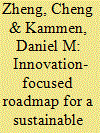

|
|
|
|
|
| Publication |
2014.
|
| Summary/Abstract |
The solar photovoltaic (PV) industry has undergone a dramatic evolution over the past decade, growing at an average rate of 48 percent per year to a global market size of 31 GW in 2012, and with the price of crystalline-silicon PV module as low as $0.72/W in September 2013. To examine this evolution we built a comprehensive dataset from 2000 to 2012 for the PV industries in the United States, China, Japan, and Germany, which we used to develop a model to explain the dynamics among innovation, manufacturing, and market. A two-factor learning curve model is constructed to make explicit the effect of innovation from economies of scale. The past explosive growth has resulted in an oversupply problem, which is undermining the effectiveness of "demand-pull" policies that could otherwise spur innovation. To strengthen the industry we find that a policy shift is needed to balance the excitement and focus on market forces with a larger commitment to research and development funding. We use this work to form a set of recommendations and a roadmap that will enable a next wave of innovation and thus sustainable growth of the PV industry into a mainstay of the global energy economy.
|
|
|
|
|
|
|
|
|
|
|
|
|
|
|
|
| 14 |
ID:
175250


|
|
|
|
|
| Summary/Abstract |
Solar energy is one of the most valuable renewable sources of energy for the socioeconomic development of a nation. Despite Myanmar has abundant solar energy resources, there are some obstacles that hinder the development of solar energy in Myanmar. To this end, this study uses contingent valuation method to estimate the public willingness-to-pay for solar energy research and development in Myanmar. Based on the survey of 550 respondents, this study indicates that, on average, Myanmar residents are willing to pay an additional 1500 kyat ($1) per month per household for research and development of Myanmar's solar energy. The total annual willingness-to-pay for the research and development of solar energy in Myanmar is estimated at 198 billion kyat ($132 million). Respondents' education level, monthly household income, knowledge of energy issues, degree of concern about energy issues, and awareness of the benefits of solar energy influence their willingness-to-pay decisions, while bid prices have a significant negative impact on their willingness-to-pay decisions. In addition to these factors, this study estimates willingness-to-pays for different geographic locations in Myanmar. This study provides Myanmar authorities with useful and important insights to develop more effective renewable energy policies for solar energy development across the country.
|
|
|
|
|
|
|
|
|
|
|
|
|
|
|
|
| 15 |
ID:
098575


|
|
|
|
|
| Publication |
2010.
|
| Summary/Abstract |
Energy innovation plays a crucial role in the reduction of carbon emissions. In order to design climate and energy policies that promote the development, deployment and diffusion of new energy technologies, policy makers not only require a theoretical understanding of the energy innovation system, but also empirical evidence of the effects that policy actions have had. This paper focuses on public energy R&D, a traditional and controversial option among the various climate technology policies, and empirically analyses its relationship with carbon emissions per GDP (i.e. carbon intensity) and its two components: energy intensity and the carbon factor. Evidence of the causality links that have prevailed in 13 advanced economies over the 1980-2004 period has been obtained through dynamic panel models. Our findings confirm that government R&D spending is not sufficient by itself to boost the energy innovation process. Public energy R&D has been successful in improving energy efficiency at country level, but it has failed to have a significant impact on the carbon factor and carbon intensity. At the same time the formation of energy R&D budgets is found to be significantly affected by carbon trends.
|
|
|
|
|
|
|
|
|
|
|
|
|
|
|
|
| 16 |
ID:
182771


|
|
|
|
|
| Summary/Abstract |
Whereas numerous studies have evaluated the effects of public research and development (R&D) support programs and R&D tax incentives on private R&D, little is known about local governments' fiscal incentives for R&D. In this study, we build a conceptual framework to clarify the critical role of local land supply in relation to fiscal expenditure on R&D. We treat the establishment of China's nine Land Supervision Bureaus in 2006 as a quasi-natural experiment, and run a difference-in-differences regression to identify causality. The results show that local governments allocate more fiscal expenditure to R&D in response to land-use supervision, which monitors illegal land granting behaviors, and this effect is stronger in cities where leaders have higher political career incentives and cities with greater fiscal decentralization. Moreover, we find that land-use supervision increases the probability and scale of firms' access to government subsidies for R&D; thus, enhancing regional innovation capacity. Our findings document that China's land resource is a curse for its innovation-driven growth as it impedes local governments' fiscal incentives for R&D.
|
|
|
|
|
|
|
|
|
|
|
|
|
|
|
|
| 17 |
ID:
180141


|
|
|
|
|
| Summary/Abstract |
This paper aims to analyze the impacts of emission taxes, investments in the energy sector, expenditure on research and development, technological innovation, and tertiary sector development on the Chinese provincial carbon dioxide emission figures between 1995 and 2019. The econometric analysis involved the application of the latest methods which can simultaneously account for cross-sectional dependency, slope heterogeneity, and structural break issues in the data. The overall findings revealed that provincial growth and tertiary sector development were responsible for the aggravation of the carbon dioxide emission trends in China. In contrast, higher energy investments, technological innovation, renewable energy use, expenditure on research and development, and carbon emission taxes are found to abate carbon dioxide emissions and, therefore, facilitate the carbon-abatement agenda of China. Besides, the findings also revealed emission taxes, investment in research and development, technological innovation, and renewable energy use jointly reduce carbon dioxide emissions further. In line with these abovementioned findings, several policy-level recommendations are put forward.
|
|
|
|
|
|
|
|
|
|
|
|
|
|
|
|
| 18 |
ID:
046543
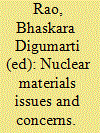

|
|
|
|
|
| Publication |
New Delhi, Discovery Publishing House, 2001.
|
| Description |
1001p.
|
| Standard Number |
817141611X
|
|
|
|
|
|
|
|
|
|
|
|
Copies: C:2/I:0,R:0,Q:0
Circulation
| Accession# | Call# | Current Location | Status | Policy | Location |
| 045436 | 355.825119/BHA 045436 | Main | On Shelf | General | |
| 045437 | 355.825119/BHA 045437 | Main | On Shelf | General | |
|
|
|
|
| 19 |
ID:
111903


|
|
|
|
|
| Publication |
2012.
|
| Summary/Abstract |
The Office of the Chief Scientist (OCS) provides public financing for high tech Research and Development. This article describes the OCS and its evolution since 2000, and assesses the government's response to crises in venture capital financing during 2001-03 and 2008-10. It finds that the government's response was inadequate in 2001-03; the OCS budget was reduced, and essential reforms were adopted belatedly. In 2008-10, the picture is mixed; the OCS budget was increased in 2009, then reduced in 2010. In July 2010, the government proposed a comprehensive package of reforms, whose impact remains to be seen.
|
|
|
|
|
|
|
|
|
|
|
|
|
|
|
|
| 20 |
ID:
004725
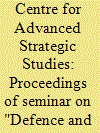

|
|
|
|
|
| Publication |
Pune, Centre for Advanced Strategic Studies, 1993.
|
| Description |
34p.
|
|
|
|
|
|
|
|
|
|
|
|
Copies: C:1/I:0,R:0,Q:0
Circulation
| Accession# | Call# | Current Location | Status | Policy | Location |
| 035657 | 338.47355/PRO 035657 | Main | On Shelf | General | |
|
|
|
|
|
|
|
|
|